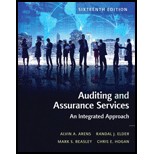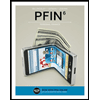
What are the information and established criteria for the audit of Jones Company’s tax return by an internal revenue agent? What are they for the audit of Jones Company’s financial statements by a CPA firm?
Provide the information and established criteria for audit of Company J’s tax return by the internal revenue agent and also explain the matters that are considered for audit of Company J’s financial statement by CPA firm.
Explanation of Solution
Information should be available in verifiable form and maintain the standards that are required by the auditor to evaluate the information. The information to be received for Company J tax return is from the federal tax returns that are filed by the company, moreover the criteria for establishment are provided by the Internal Revenue code and its interpretations. Whereas, financial statement of Company J are audited by the criteria provided by Country U GAAP or IFRS.
Want to see more full solutions like this?
Chapter 1 Solutions
Auditing and Assurance Services (16th Edition)
- Maxim Corporation purchases equipment at the beginning of the year at a cost of $75,000. The equipment is depreciated using the straight-line method. The equipment's useful life is estimated to be 8 years with a $15,000 salvage value. The book value of the equipment at the end of year 4 is _.arrow_forwardPlease provide the answer to this general accounting question using the right approach.arrow_forwardI need help with this general accounting problem using proper accounting guidelines.arrow_forward
- Fargo Wellness Center has total equity of $1,040,000, sales of $1.88 million, and a profit margin of 5.2 percent. What is the Return on Equity (ROE)?arrow_forwardSolve this Accounting problemarrow_forwardPlease explain the solution to this general accounting problem using the correct accounting principles.arrow_forward
- Can you solve this general accounting problem using accurate calculation methods?arrow_forwardJessica Electronics manufactures home automation devices. The company incurs variable manufacturing costs of $28 per unit and total fixed manufacturing costs of $392,000. If 7,000 units are manufactured and the company uses the absorption costing concept, what is the manufacturing cost per unit?arrow_forwardPlease provide problem with accounting questionarrow_forward
 Pfin (with Mindtap, 1 Term Printed Access Card) (...FinanceISBN:9780357033609Author:Randall Billingsley, Lawrence J. Gitman, Michael D. JoehnkPublisher:Cengage Learning
Pfin (with Mindtap, 1 Term Printed Access Card) (...FinanceISBN:9780357033609Author:Randall Billingsley, Lawrence J. Gitman, Michael D. JoehnkPublisher:Cengage Learning PFIN (with PFIN Online, 1 term (6 months) Printed...FinanceISBN:9781337117005Author:Randall Billingsley, Lawrence J. Gitman, Michael D. JoehnkPublisher:Cengage Learning
PFIN (with PFIN Online, 1 term (6 months) Printed...FinanceISBN:9781337117005Author:Randall Billingsley, Lawrence J. Gitman, Michael D. JoehnkPublisher:Cengage Learning





